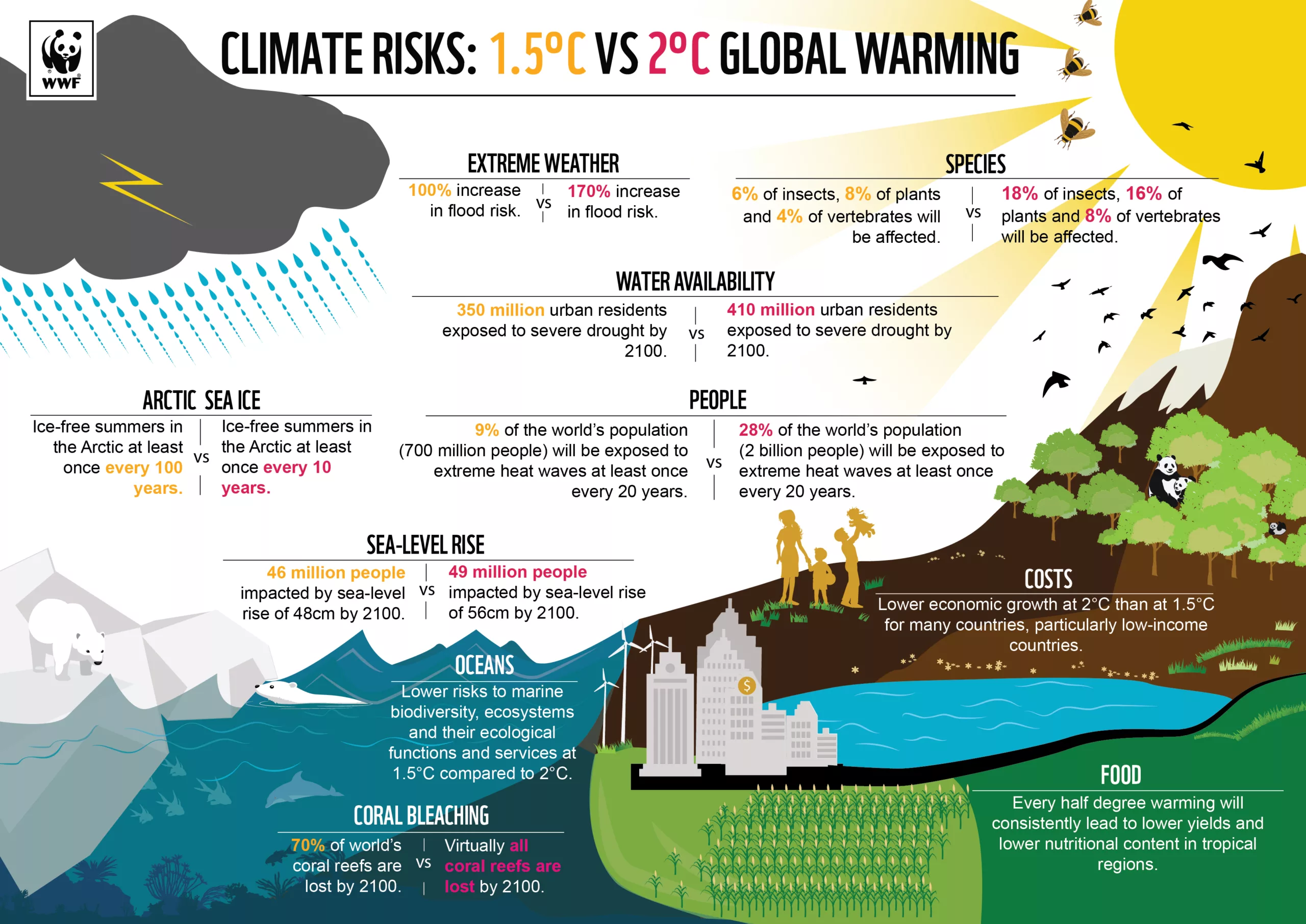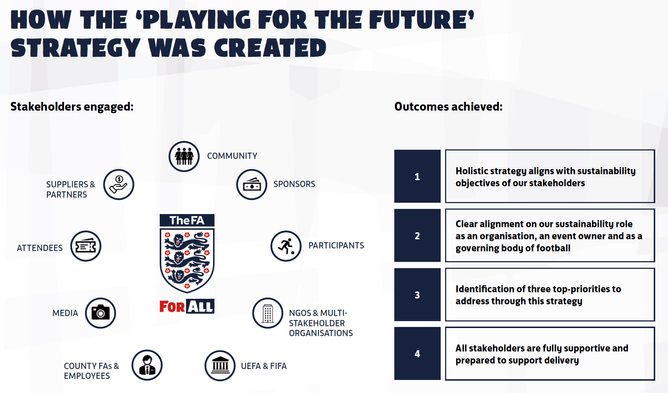Football and Climate Change: The Necessary Debate
“As the reality of climate chaos pounds communities around the world- with ever-fiercer floods, fires and droughts- the chasm between need and action is more menacing than ever,” – António Guterres (UN Security General).
Would you believe me if I told you that a whole lot of football stadiums across the globe will face annual flooding by 2050? What about the prospect of matches and maybe whole tournaments being postponed or cancelled due to similar extreme weather conditions like heat waves? If you don’t, get ready to, because whether you like it or not, the spectre of climate change is already looming, and football is certainly on its hit list, just like everything else on the planet.
In all its manifestations, global warming presents a pressing danger to the intricate harmony of ecosystems globally, putting at risk both human communities and the diversity of life. Should we, as a whole society, falter in curbing the temperature surge below 1.5 degrees Celsius by 2030, the repercussions could be catastrophic, as underscored by climate experts.
Back to football, clubs in England and the rest of Europe have already reported unpleasant news about their stadiums getting drowned over the years. As per Sky Sports reports, one-third of grassroots pitches in England currently face a minimum six-week downtime due to flooding and insufficient drainage, leading to the postponement of 9,000 to 10,000 games at the grassroots level every season.

Not only flooding but extreme heat waves, poor air quality, extra torrential rains, heavy storms etc, are also at the forefront, posing a threat to the quality and even the prospect of sustaining the leagues and tournaments. While larger clubs might manage these challenges with significant funding, smaller ones may not have the financial resources to cope with situations costing millions at once, leaving the stadium barely playable. Despite the scale disparity, the aftermath remains consistent – the league gets compromised.
From a football perspective alone, this news is crucial for millions worldwide who can’t imagine a weekend without the sport. It underscores its significant impact on the global fanbase and everyone involved in the game in various capacities.
Now, some of you who are aware of the unfolding tragedy may ask, why football? It is neither the primary perpetrator nor the sole victim of the climate horrors. Well, you are right to an extent. Not everybody shares the same responsibility, and everyone is affected differently. Climate change experts and scientists over the past few decades have pointed out Big Oil, rich industrialized countries, and carbon billionaires as the chief catalysts behind the universal crisis. That’s true.
But none of these facts excludes football from its necessary responsibilities. Intentionally or not, football assumes the role of a culprit as its structures are responsible for systematically emitting a considerable amount of carbon. An even greater problem lies when this recurring pattern doesn’t have parallels in the realm of antidotes or solutions. Hence, the concern and a need for serious thought and robust action. We are already a little bit late.
So, let’s take a walk into the deep woods to discover what lies ahead, uncovering what the media and corporations aren’t telling us about football and climate.
How Football Impacts Climate
If you are an intimate follower of the game, especially European football, you may have observed the game’s unprecedented expansion over the past decade. Budding up tournaments, increased number of teams, and additional matches are a new normal now. Even the supreme tournament under the banner of FIFA, the World Cup is about to host 48 teams in the coming edition- an addition of 16 teams to the status quo.

While these are enjoyable to the hearts and minds of the fans, they prove detrimental to the players and the environment. If players face the threat of exhaustion and injuries, the environment is left with increased carbon release. Because when football is on the rise, so too is its ecological footprint, leading to a broader influence on the climate. Wondering how? Let me break it down.
Travel
More games and tournaments mean more players, staff, and fans travelling. When they travel, it’s mostly by air because clubs have a shorter timeframe for rest and training before the next league or tournament, which may be a couple of days away. For instance, the next two World Cups will be hosted by three different countries each, instead of a single one. This setup amplifies the travel needed between matches. The farther the distance or the tighter the time for return, the less likely it is for public transport to be chosen.
Stadium Operation and Maintenance
Stadiums are stunning to glance at and enjoy. But they are also costly to build and maintain. More importantly, it requires a massive amount of energy to run even a single match. When I say massive, I mean enough electricity to power more than a dozen households for an entire year or a small town for the duration of a mere 90 minutes. Yeah, that is what it takes. To be more precise, an average football match consumes about 15,000 to 30,000 KWh, depending on the stadium’s size, opines The Sports Journal.
Now, this is just a picture, a single one. The numbers vary from season to season. If the winter period requires heated seats and turf, warmer contexts require extensive air conditioning, which again takes up extra energy. More recently, we even saw the air-conditioned pitch, to quote the memory of the Qatar WC 2022. But these are minor consumptions when compared to the energy required for floodlighting, scoreboards, and advertising LED boards, where its utilization rises to a staggering 40%, the highest of them. Additional energy demands arise from the need to heat food and keep beverages cold, accounting for over 20% of a stadium’s total energy consumption.

Furthermore, the process of live broadcasting, enabling football fans worldwide to watch and engage with the game, involves robust satellite transmitters, multiple HD cameras, and purpose-built editing suites. This entire infrastructure collectively consumes around 11% of the stadium’s total energy. Then there is the necessity to maintain the pitch to optimal condition, which requires an immense amount of water, heating to avoid freezing, and energy-intensive lighting systems to facilitate grass growth, such as the ‘LED grass grow lighting technology’. The list goes on.
Clothing Industry/Club Merchandise
According to Sky Sports Football, the people of the UK buy 2 tonnes of clothes every minute. In other words, the environmental impact of this sole activity surpasses that of circumnavigating the globe by plane 900 times, which is slightly concealed by the football pundits when it comes to climate discussions. Now, imagine the number of kits bought worldwide daily through club merchandise, with each club introducing three new kits every year.
Diet
This point is slightly debatable as a major portion of this downside is hurled against meat eaters or individuals who prefer meat as their dietary option, which I think is shallow. Because, in a way, this leaves out the big guys aside, like the corporates who run this large industry. A handful or even a legion of football fans opting for a vegan diet does not stop the livestock farmers, be it small-scale or big shots, from producing meat. Hence, promoting or discouraging veganism for football fans yields benefits that are yet to be fully understood, one should assume. But still, it’s an argument.
Now, presenting all these downsides isn’t meant to suggest a moral high ground or to be confused with a sense of complete inactivity or chaos in the football world. There are indeed clubs, initiatives, and policies in place that are taking the necessary baby steps in the right direction.

To offer a few examples, 12 of the 92 clubs in England from the three divisions combined have already made a public net-zero commitment, of which six are from the PL. 39 of them, including nine from the PL, have published an environmental statement, policy, or strategy. On the same note, Bundesliga and Ligue 1 are integrating environmental sustainability into their licensing systems, while Spain and Italy have implemented sustainability strategies across their top football leagues. Apart from these collective initiatives, individual players and clubs are doing their part out of sheer concern for the planet too. However, all of these fall short of the mark. Football, being the most popular world in the entire world, has the power and responsibility to do more to lead and dominate the fight. Displays of isolated and random efforts, even though brave, should be coordinated to work as a single machine if we are to reap concrete results.
What Can Football Do?
Here’s the thing. There’s not a one-size-fits-all scheme when it comes to what football should do or can do to aid the battle against climate change. However, there are clear guidelines, hints, methods, and models that can be adopted by every club, fan, or player based on their capacities – pathways that guarantee results and take the march forward. But keep in mind, the same is also a journey that requires the help of inter-football and intra-football supreme bodies like FIFA and the Govt bodies, respectively. Fans, too, have their share of say. So, let’s discuss the possibilities.
To kick things off, in association with UEFA and other continental bodies, FIFA should discuss readjusting their football calendars to host fewer matches than the status quo because fewer matches equals reduced air travel and even less exhaustion for the players.
On the same note, clubs should also persuade the players and management to rethink team travel systems like private jets for inter-match trips. Where and if possible, try hosting matches within a travelable distance, like in the case of pre-season tours and friendlies. Most recently, the Qatar World Cup even took it a step further and displayed a splendid effort in organizing an entire World Cup within commutable range.

Whatnot, they even introduced the first fully demountable stadium, sustainable stadium cooling technology (with energy savings of up to 45%), and a network of electric vehicle charging points to inspire the industry further.
Moving on, every club should hire an ‘environment sustainability head’ at their helm to guide them into sustainable practices, measures, and enhanced awareness at all club levels. If the reports from ‘The Athletic’ are right, clubs in England have already followed suit and institutionalized the position.
Governments can be a great help in this case. They can quite function as the necessary bridge between the clubs, inter-football bodies, and fans when it comes to executing matters. Starting with a subsidized public transport system for the club fans, national or local authorities of each respective league can further dive into the climate issue by advising and regulating clubs to healthy practices. If we are to halve carbon emissions by 2030 globally, we need rigid and absolute schemes, like an independent government-affiliated regulator.
At the outset, such regulatory bodies should influence and pressure the entire football pyramid in their respective leagues, in a top-to-bottom approach, to necessarily opt for sustainable practices and policies such as signing up for initiatives like the United Nations Framework Convention on Climate Change (UNFCCC) or the United Nations ‘Race to Zero’ for Sport in addition to allocating sustainability funds.
In September 2022, UEFA unveiled its ‘Circular Economy Guidelines’ as a pivotal component of its Football Sustainability Strategy 2030. The objective is to optimize the consumption and life cycle of various products, including food, packaging, and branded items, throughout UEFA’s operations and events. The guidelines adhere to the “4R approach”—reducing, reusing, recycling, and recovering—aiming to minimize football’s environmental impact and enhance overall resource efficiency.
While the UNFCCC, in collaboration with FIFA and UEFA, launched a promising framework known as the UN Sport for Climate Action Framework in 2016 (concentrating on involving sports organizations in minimizing emissions from their operations and utilizing the widespread appeal of sports to engage fans in climate action), there is an absence of immediate actions or clear, defined targets within the framework.
Still, if executed with extra care and purpose, these independent bodies can foster a sustainable framework by gradually implementing regulations that specify environmental standards for aspects such as carbon emissions, sponsorships, waste management, education, and more.
Governments should also prioritize establishing solar power and wind turbines, or investing in any other form of green energy, along with researching alternative materials. This is particularly crucial since smaller clubs may find it financially challenging to implement such initiatives independently. But before all this, clubs should install a mechanism or seek the assistance of machinery that calculates their carbon footprint, such as ‘ClimateTrade,’ a climate data/carbon footprint measuring company.
Because to dress the wound perfectly, you need to know its size. One can also turn to initiatives like “Football for Future” a non-profit organization committed to addressing environmental and sustainability issues in football. It promotes sustainable actions such as reducing carbon emissions, advocating for eco-friendly infrastructure, and raising awareness about environmental conservation among players, clubs, and fans.

Therefore, implementing a data collection and dissemination system that helps the clubs understand where they stand and what they can do about it is a great place to start. Although football bodies in England, like the FA have frameworks such as the “FA Sustainability Strategy,” for the same, they have notable gaps in measuring accurate carbon footprint and funding allocations accordingly.
But no worries. Clubs that genuinely care, which all of them should, can look at what Forest Green Rovers FC has done. Deemed by FIFA as “the greenest club in the world,” the 134-year-old club from Gloucestershire also boasts the ownership of the world’s first “organic football pitch,” named “The New Lawn.” From an all-around renewable energy setup that powers their internal operations to running a free educational program for schools and the local community called “Fit2Last”, Forest Green Rovers is the apex leader when it comes to climate.
They are the only club to have the ‘Eco-Management and Audit Scheme (EMAS) accreditation’, a special certification for organizations that want to be good at taking care of the environment. Such an exceptionally noteworthy accreditation demonstrates their adherence to strict rules for measuring, reporting, and improving their treatment of nature—something other clubs should consider adopting.
Furthermore, clubs can make it a norm to exclusively wear outfits made from recycled materials. Forever. Discarding the yearly change of kits by clubs can also significantly reduce the sheer number of kits floating around. Fans, in celebration of their love and loyalty, can opt for retro kits, which are quite fashionable. Food is another arena where small initiatives can be taken to
champion the cause. Embracing a plant-based diet or reducing meat consumption, some argue, can exert influence on the livestock industry to scale back production, which is a positive outcome if deemed credible. Implementing efficient food waste management at stadiums during match days throughout the seasons can also yield positive impacts if carried out systematically.

Cancelling sponsors who have the least regard for the environment. may also prove as a key move to enforce healthy practices.
Ultimately speaking, climate emergency, as we all acknowledge, is also a social issue as much as it’s an environmental issue.
Football, although not in its best capacity, has been addressing pressing social concerns such as racism and violence through its varied platforms for decades. The same can be done with climate. Messages can be conveyed, and people, including climate science denialists, may follow suit.
To quote the words of Swindon Town FC’s Chief Sustainability Officer, Michael Doughty, “Once people realise that the product is under threat, and you start seeing crappy football matches in 40C heat, there will be much more momentum behind it. And that’s only a matter of time. Because the science is unequivocal.”
Hence, let’s work in unison for our planet. For us and the generations to come. Because there is no plan or planet B if we fail.
Note: Please be aware that the solutions outlined in this article stem from a combination of research data and personal reflections. It’s important to note that the author does not claim expertise or professional qualifications in the field of climate science. Rather, their insights are shared to add to the ongoing dialogue and raise awareness about the significance of tackling climate change.
Discover more from
Subscribe to get the latest posts sent to your email.


